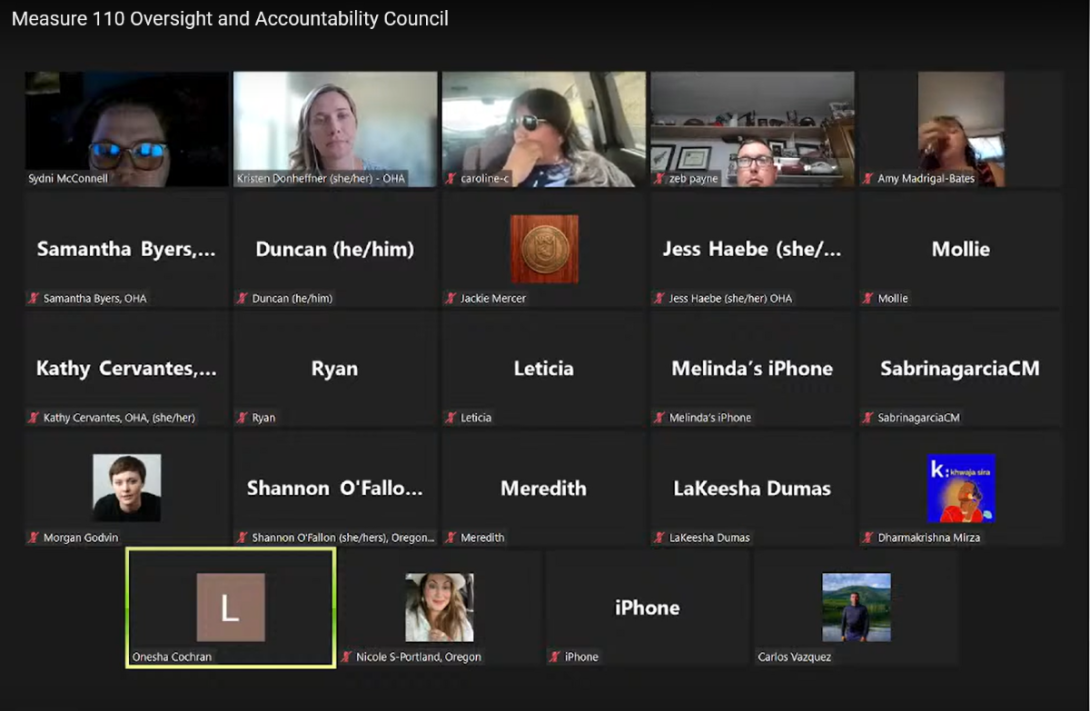
This story has been updated and expanded with additional reporting.
The state will provide Oregon’s three largest counties with an estimated $55 million less for addiction recovery services than their populations call for over the next several years.
Lawmakers substantially rolled back aspects of Measure 110, the voter-approved decriminalization measure earlier this year. But the oversight council that oversees the funding stream it created is still in place, and it adopted a revised funding formula intended to help rural counties on July 3.
Some council members raised concerns, however. O’Nesha Cochran, a manager at Portland-based recovery center Miracles Club, noted that two of Oregon’s largest counties, Multnomah and Washington, are among the state’s most diverse and have the largest Black populations. The formula undermines Measure 110’s goal of addressing the harms to minority communities that stem from years of drug prohibition, she added.
“I’m just getting confused because this was supposed to be for those most impacted by drugs,” she said. “BIPOC communities are those most impacted by drugs.”
Measure 110 set up the oversight council to be made up of people with lived experience or who work in addiction recovery fields. By a vote of 12-5, its members adopted the new formula to guide how it awards an estimated $427 million in grants paid for by cannabis taxes that the measure diverted from schools and state and local agencies.
“I’m just getting confused because this was supposed to be for those most impacted by drugs. BIPOC communities are those most impacted by drugs.”
Previously, the council used a formula that took into account counties’ Medicaid recipients, houseless population, arrests and drug overdoses. It also ensured Oregon's five smallest counties receive a minimum of $750,000 over 18 months.
The formula adopted by the council last week expands the funding minimum to four more of Oregon’s sparsely populated counties. While state officials say it’s very similar to the previous formula, the stakes are higher now. That’s because state officials project the council to distribute $25 million-a-year less to local governments than it has in the past.
The revised formula stems from legislative changes to the program. Providing at least $2 million over four years to each of Oregon’s nine counties with populations less than 20,000 — Baker, Morrow, Lake, Harney, Wallowa, Grant, Gilliam, Sherman and Wheeler — is intended to help address rural disparities in access.
In an earlier meeting, Kristen Donheffner, an Oregon Health Authority manager who oversees implementation of Measure 110 services, told the council that the new formula will “smooth out some of the differences between the extra large and extra small counties” and make negotiations easier during the grant process that begins later in July.
But, she added, “If you’re bringing up these smaller counties, you’re going to have to bring down the bigger ones.”
Since July 2022, the council has awarded $265 million in grants to the 42 behavioral health resource networks that were set up under the Measure 110 law to help distribute funding. These networks provide screening, intervention planning, peer support, some treatment and services intended to minimize the risks and harms to people using substances such as meth and opioids.
So far, Multnomah County has received $59 million, Washington County $21 million and Clackamas $14 million, according to the state. Eight counties in eastern Oregon each received under $1 million, while other counties received millions more.
“If you’re bringing up these smaller counties, you’re going to have to bring down the bigger ones.”
Jonathan Duncan, a peer services manager at the HIV Alliance, said during the July 3 meeting that while rural areas have fewer people service providers face significant per-person costs, especially when considering transportation.
Caroline Cruz, health and human services manager for the Confederated Tribes of Warm Springs, welcomed the formula, calling the last grant cycle in 2022 a “nightmare.”
“I don’t think anything that we’re going to do is going to be fair,” said Cruz, adding that it was important to get the money allocated.
Dharma Mirza, the council’s tri-chair and Oregon State University doctoral student, replied that the rush to allocate the money means “we continue to just entrench ourselves in a racist dissemination of funding that doesn’t actually address the problem.”
Counting counties
Donheffner last month presented the council with figures comparing the new formula’s estimated funding with what each county’s share of Measure 110 funding over the next four years would be based solely on population. While the council has never distributed Measure 110 funds based solely on population, she said the figures could give the council “a sense of scale” for how the formula would play out.
Under the formula, Multnomah County will receive an estimated $74.7 million in Measure 110 funding over the next four years, $7.5 million less than if funding were allocated based on population.
The impact of the formula is even greater for the two other counties in the Portland region. Washington County, the state’s second most-populated county, will receive $33 million, only slightly more than half of what it would receive under a solely population-based formula. It’s also only about $1 million more in funding than Jackson County, which is a third of its size.
Clackamas County will receive $22.7 million, which is also only slightly more than half of what it would receive by population. That’s also about $2 million less than Deschutes County, which has a population half of its size.
A Washington County spokesperson wrote in an email to The Lund Report that the newly adopted formula serves to “hamper the county’s ability to provide addiction treatment services” while making it harder to meet requirements of legislatively mandated “deflection programs” to get people into treatment rather than jail.
In a statement, Washington County Board Chair Kathryn Harrington called on the Legislature to create a better system for distributing the funds, saying the Measure 110 grant budget “requires a more transparent, iterative and thoughtful process than the one that was utilized for the new funding formula.”


